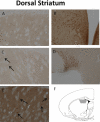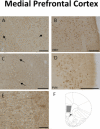Estrogen receptors in the central nervous system and their implication for dopamine-dependent cognition in females
- PMID: 26122294
- PMCID: PMC4820286
- DOI: 10.1016/j.yhbeh.2015.06.010
Estrogen receptors in the central nervous system and their implication for dopamine-dependent cognition in females
Abstract
This article is part of a Special Issue "Estradiol and cognition". Over the past 30 years, research has demonstrated that estrogens not only are important for female reproduction, but also play a role in a diverse array of cognitive functions. Originally, estrogens were thought to have only one receptor, localized exclusively to the cytoplasm and nucleus of cells. However, it is now known that there are at least three estrogen receptors (ERs): ERα, ERβ and G-protein coupled ER1 (GPER1). In addition to being localized to nuclei, ERα and ERβ are localized to the cell membrane, and GPER1 is also observed at the cell membrane. The mechanism through which ERs are associated with the membrane remains unclear, but palmitoylation of receptors and associations between ERs and caveolin are implicated in membrane association. ERα and ERβ are mostly observed in the nucleus using light microscopy unless they are particularly abundant. However, electron microscopy has revealed that ERs are also found at the membrane in complimentary distributions in multiple brain regions, many of which are innervated by dopamine inputs and were previously thought to contain few ERs. In particular, membrane-associated ERs are observed in the prefrontal cortex, dorsal striatum, nucleus accumbens, and hippocampus, all of which are involved in learning and memory. These findings provide a mechanism for the rapid effects of estrogens in these regions. The effects of estrogens on dopamine-dependent cognition likely result from binding at both nuclear and membrane-associated ERs, so elucidating the localization of membrane-associated ERs helps provide a more complete understanding of the cognitive effects of these hormones.
Keywords: Dopamine; Electron microscopy; Estrogen receptor alpha; Estrogen receptor beta; G protein coupled estrogen receptor 1.
Copyright © 2015 Elsevier Inc. All rights reserved.
Figures







References
-
- Akhondzadeh S, Nejatisafa AA, Amini H, Mohammadi MR, Larijani B, et al. Adjunctive estrogen treatment in women with chronic schizophrenia: a double-blind, randomized, and placebo-controlled trial. Prog. Neuropsychopharmacol. Biol. Psychiatry. 2003;27:1007–12. - PubMed
Publication types
MeSH terms
Substances
Grants and funding
LinkOut - more resources
Full Text Sources
Other Literature Sources
Miscellaneous

